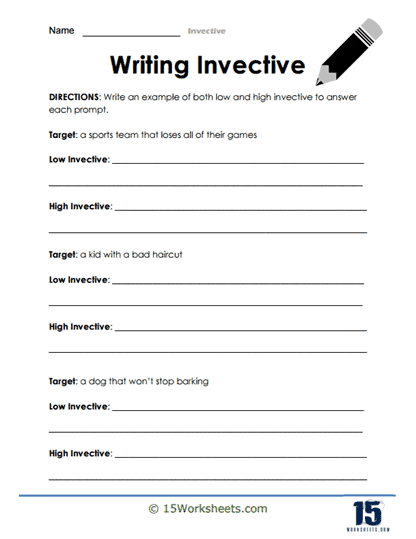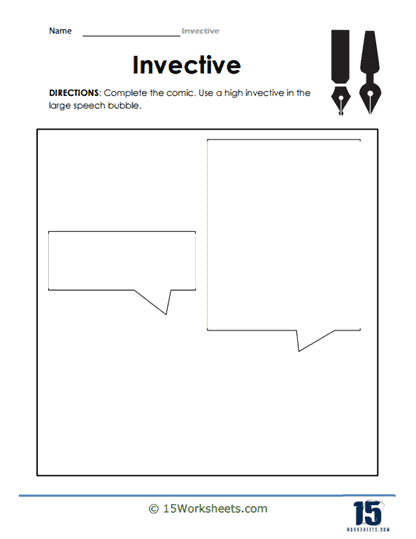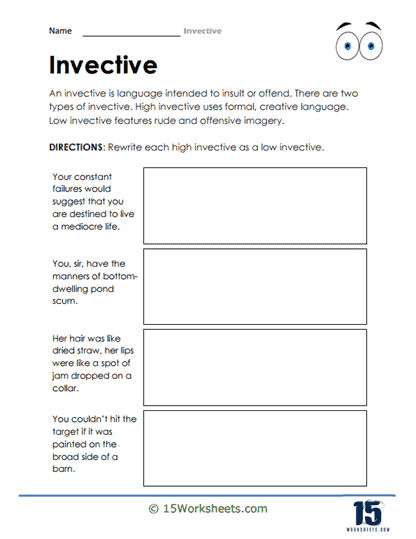Invective Worksheets
About These 15 Worksheets
These worksheets will help deepen students’ understanding of language and its emotive power. Invective, in literary terms, is the language of insult and offense; it is a rhetorical device employed to denounce or criticize a subject. The purpose of these worksheets is to engage students with this particular aspect of language, which has a rich tradition in literature and public discourse.
They provide an arena not only for the exploration of language’s expressive range but also for the cultivation of analytical, ethical, and rhetorical skills essential to reading and writing effectively.
The types of exercises found on invective worksheets can be quite varied, each serving a different educational objective:
Definition and Examples – Initially, students might encounter exercises that require them to define invective and identify examples from given texts. This foundational task ensures that they can recognize invective when they see or hear it.
High vs. Low Invective – Some worksheets will ask students to differentiate between high and low invective. High invective is characterized by formal, creative language, and may employ the use of literary devices such as metaphor and hyperbole. Low invective is more direct and often crude, using language that might be considered offensive or vulgar. This distinction helps students understand the range of expression within invective language.
Conversion Exercises – Students may be tasked with converting high invective to low invective, or vice versa. This not only challenges their understanding of the concept but also encourages them to manipulate language for different effects.
Creative Writing – Worksheets might also include creative writing prompts where students are encouraged to write their own invective in a controlled and mindful manner. This could be in the form of writing a persuasive essay, a satirical piece, or even dialogues for characters in a drama.
Reading Comprehension – Invective is often used in literature to convey characters’ strong emotions or social criticism. Worksheets may include reading passages with questions designed to test comprehension and to encourage students to think about the author’s choice of language and its impact on the reader.
Historical Speech Analysis – Invective has a long history in political speeches and public discourse. Students might analyze historical speeches to identify and reflect on the use of invective and its persuasive power.
Comparative Analysis – Some exercises will have students compare and contrast the use of invective in different texts, mediums, or contexts, such as between a political speech and a satirical poem.
Impact on Tone and Mood – Students will learn how invective influences the tone and mood of a piece. They might be asked to identify the tone and mood before and after invective is introduced into a text.
Discussion and Reflection – Worksheets may also encourage discussion or personal reflection on the ethical considerations of using invective, prompting students to think about when, if ever, its use is justified.
Practicing with these worksheets can help students improve their language arts and reading skills in several ways:
Enhanced Vocabulary – By engaging with both high and low forms of invective, students are exposed to a broad spectrum of vocabulary. This exposure can help them understand nuanced meanings and connotations of words, which is essential for reading comprehension and effective writing.
Literary Analysis Skills – Understanding invective and its use in literature is fundamental to literary analysis. Students learn to discern an author’s intent, characterize dialogue, and appreciate the stylistic choices that define a text’s voice.
Critical Thinking – Conversion exercises, in particular, foster critical thinking as students must consider the appropriate level of language for their intended message. This thought process is crucial for analyzing texts and for crafting their own written and spoken language.
Persuasive Writing – The ability to use language persuasively is a key skill in many forms of writing. Working with invective teaches students the power of words to provoke emotion and compel action, which is invaluable for argumentative essays and speeches.
Emotional Intelligence – The study of invective can heighten students’ emotional intelligence. They become more sensitive to the emotional weight of words and learn to read the emotional context of texts more accurately.
Ethical Reflection – Considering the ethical implications of invective use in communication encourages students to reflect on their own language choices and the potential impact on others, fostering a more thoughtful and responsible approach to communication.
Rhetorical Awareness – Invective is a rhetorical strategy. Practicing with these worksheets develops students’ rhetorical awareness, helping them to recognize persuasive techniques in both the texts they read and the arguments they write.
What is the Literary Device of Invective?
The literary device of invective is a speech or writing that attacks, insults, or denounces a person, topic, or institution. It involves the use of strong, abusive language and is often a feature found in polemical debates where the speaker wishes to establish a position of authority or power over the subject. The purpose of invective is not merely to express anger or displeasure, but to actively persuade or influence an audience, to criticize by means of ridicule, contempt, or mockery.
The main defining feature of an invective is its vehement or vitriolic language that is aimed at discrediting, demeaning, or expressing intense disapproval. Invective can be either high, utilizing formal, eloquent, and sophisticated language, or low, which is characterized by coarse, crude, and often offensive language.
Characteristics of invective include:
Strong Language – Invective is marked by the use of intense and forceful language. It may include profanity, but not necessarily; even without crossing into vulgarity, the words chosen are strong enough to be impactful and memorable.
Targeted – Invective is always targeted at a particular subject. It might be directed at a person, a type of person, an institution, an ideology, or even an abstract concept.
Expressive of Disapproval – The purpose of invective is to show disapproval. It goes beyond mere description and ventures into outright condemnation.
Persuasive Intent – Invective aims to persuade the audience to reject the subject it describes. It is not neutral; it carries a strong subjective stance and seeks to convince the audience of the subject’s vileness or folly.
Emotional – It often appeals to emotions rather than reason. The use of invective is designed to stir up feelings of anger, contempt, or disgust.
Hyperbolic – Invective often utilizes hyperbole or exaggeration to emphasize the negative aspects of the subject.
Rhetorical – Invective is a rhetorical device. It is used deliberately and for effect within the context of an argument or exposition.
Examples In Literature
Examples of invective in literature are plentiful, as it has been a popular device throughout history for authors to express societal critique or character conflicts. Here are three instances:
Shakespeare’s “King Lear” – One of the most famous instances of invective in English literature comes from William Shakespeare’s “King Lear”, in which the character of Kent berates Oswald, calling him a “base, proud, shallow, beggarly, three-suited, hundred-pound, filthy, worsted-stocking knave; a lily-livered, action-taking knave; a whoreson, glass-gazing, superserviceable finical rogue; one-trunk-inheriting slave; one that wouldst be a bawd in way of good service, and art nothing but the composition of a knave, beggar, coward, pandar, and the son and heir of a mongrel bitch.” This tirade of insults is a classic example of high invective. It serves to illustrate Kent’s utter contempt for Oswald, reflecting the stark division of loyalty and morality in the play, and it also adds to the development of Kent as a character who is fiercely loyal and unflinchingly honest.
Jonathan Swift’s “A Modest Proposal” – Swift uses invective in a satirical manner when he proposes that the children of the poor in Ireland be sold and consumed as a means to deal with the problem of poverty. His use of irony and hyperbole creates an invective against British policy and indifference towards the Irish people. Swift’s invective is so effectively disguised in rational economic ‘proposal’ language that it takes a moment for the reader to realize the horrific nature of the suggestion, which in turn evokes a strong emotional response of shock and revulsion.
Mark Antony’s speech in Shakespeare’s “Julius Caesar” – After Caesar’s assassination, Mark Antony’s speech to the public serves as an invective against the conspirators, branding them as “honorable men” in a tone dripping with sarcasm. The repeated use of “honorable” becomes a scathing attack on their treachery, turning the crowd against them. This use of invective is particularly clever because Antony never directly insults the conspirators; instead, he uses their own claim to honor against them to enrage the public.
The effect of invective on the reader can be profound. It can serve to align the reader’s sympathies with the writer or speaker, creating a shared sense of injustice or anger at the subject of the invective. The emotional charge of invective language can be a powerful motivator for change or action. It can also provoke a defensive reaction, especially if the reader identifies with the target of the invective. Moreover, invective can contribute to the tone and mood of a piece, imbuing it with an atmosphere of tension, conflict, or indignation. In satire, invective can be used to humorous effect, allowing the reader to engage with serious social critique in a way that is entertaining and accessible.















